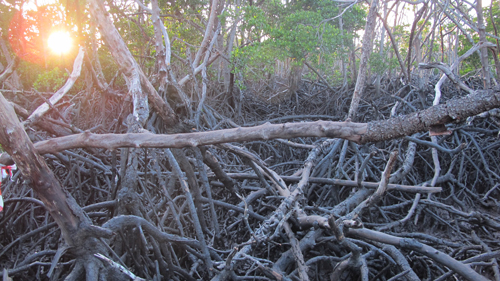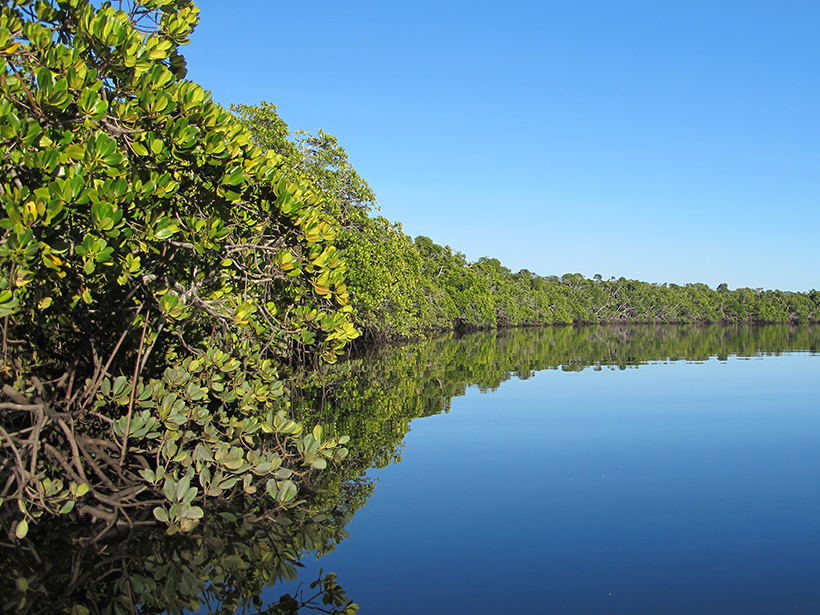Source: Global Biogeochemical Cycles
The burning of fossil fuels, the production of cement, and industrial-scale agriculture have all contributed to a significant rise in carbon in our atmosphere. This ultimately takes a toll on our oceans, which have absorbed approximately one third of this anthropogenic carbon. When carbon dioxide (CO2) dissolves in water, it decreases pH in a process called ocean acidification. This acidification ultimately harms ecosystems like coral reefs and affects the livelihood of phytoplankton, a food source for many marine animals. Because alkaline solutions can buffer acidic ones, the phenomenon of ocean acidification has caused scientists to become interested in alkalinity-producing pathways.
One ecosystem in particular is thought to increase alkalinity: mangrove forests. Through natural biogeochemical cycling, mangroves are known to increase the alkalinity of the waters surrounding these ecosystems. In a new study, Sippo et al. investigate the extent to which mangroves can counter ocean acidification.

The scientists studied the dissolved inorganic carbon (DIC) content, alkalinity, and dissolved carbon dioxide in the waters of six pristine mangrove tidal creeks along the northern, eastern, and southern coasts of Australia. The researchers also collected water samples from nearby coastal waters to see if the alkalinity of the mangroves’ waters had a detectable influence on the surrounding area. Plants, like mangroves, naturally cycle carbon, meaning they remove it from the air and convert it into biomass. The high productivity of mangrove forests, and their unique location at the land-ocean interface, results in a large soil reservoir of carbon. The subsequent breakdown of this soil carbon can produce alkalinity. Using titration to measure the alkalinity in the mangrove forest waters, the scientists calculated the exchange of DIC, alkalinity, and dissolved CO2 from the mangroves to the coastal ocean.
On average, the mangroves studied put out 59 millimoles of DIC per square meter in one day into the surrounding coastal waters. Scaling up these estimates would result in global exports of more than 2.5 × 109 moles of carbon per year. The authors also calculated that mangrove forests can annually export up to 4.2 teramoles of alkalinity.
Overall, the effect of dissolved inorganic carbon and alkalinity exports from the mangroves caused nearby ocean pH to increase. The authors believe that this boost in pH from the mangroves is likely to have a greater effect in areas with large mangrove coverage. This localized effect may have important implications for other tropical coastal ecosystems, such as coral reefs.
According to the authors, this study is one of the most comprehensive assessments of the contribution of mangroves to ocean alkalinity to date. In addition to all of the important ecological functions, this new research shows that mangroves are one of the largest natural sources of alkalinity to tropical coastal oceans. (Global Biogeochemical Cycles, doi:10.1002/2015GB005324, 2016)
—Wudan Yan, Freelance Writer
Citation:
Yan, W. (2016), Can mangroves buffer ocean acidification?, Eos, 97, https://doi.org/10.1029/2016EO053819. Published on 09 June 2016.
Text © 2016. The authors. CC BY-NC-ND 3.0
Except where otherwise noted, images are subject to copyright. Any reuse without express permission from the copyright owner is prohibited.

